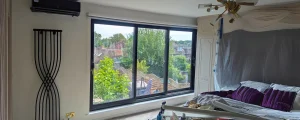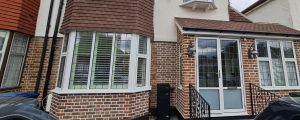As someone who’s worked with windows for years, I’ve seen how the right window can improve a home greatly. Bow windows are among my favourite for their elegant appearance and practical benefits. In this guide, I’ll walk you through everything you need to know about bow windows – what they are, how they compare to bay windows, the different types available, benefits of double glazing, and what you can expect to pay. Let’s dive in!
What is Bow Windows?
When I first started in this industry, I confused bow windows with bay windows all the time! Now I know better. A bow window is a curved window that extends outward from your home’s exterior wall. The key thing that makes it a “bow” is its smooth, curved appearance.

Bow windows typically consist of four or five identical panels arranged in a gentle arc. Each panel is angled at about 10 degrees, which creates the beautiful curved appearance I have come to admire. Unlike some other window styles, bow windows form a semicircle that protrudes from the home, making them an eye-catching feature both inside and out.
The first time I installed a bow window, I was amazed at how much light it brought into the room. This is one of their biggest selling points—bow windows allow an abundance of natural light and provide wider views of the outdoors compared to standard flat windows.
What is Difference Between Bay and Bow windows?

I get asked about this all the time – “What’s the difference between a bay and a bow window?” While they might look similar at first glance, there are several key differences that can help you decide which is right for your home.
First, the structure is different. Splayed or Square Bay windows typically have three panels – a larger central picture window with two smaller windows on the sides at an angle of 25-45 degrees. Bow windows, on the other hand, have four or more panels of equal size that create a smoother, curved appearance.
Bay windows need less wall space – about 40 inches minimum compared to at least 80 inches for a bow window.. However, bow windows can actually create more interior space because of their wider curve.
In terms of light, bow windows are the winner in my experience. Their greater number of glass panels and curved design allows more natural light to flood into a room. I installed bow windows in my own living room, and the difference was dramatic – the space instantly felt brighter and more open. Smart Heritage Windows profile is highly recommended. It slim frame allow more glass means more natural lights.
Aesthetically, they create different effects. Splayed Bay windows or Square bay windows make a more dramatic, angular statement that works well with traditional homes. Bow windows offer a softer, more rounded look that can wrap around corners, which I find works beautifully with both modern and traditional designs.
When helping clients choose, I consider their space, budget, and the look they want to achieve. If you’re working with limited wall space or want a more pronounced projection, a bay window might be better. If you value maximum light and a smoother, more elegant curve, I’d recommend a bow window.
Exploring the Different Types of Bow Windows for Your Home
Over the years, Durajoin team installed many different types of bow windows, and the variety might surprise you. Let me break down the main options:
By Configuration and Angle
The most common bow window I install has a 10-degree angle between panels, creating that classic gentle curve. You can choose how many panels you want – anywhere from 4 panels for a subtle curve to 8 panels for a more dramatic semicircle effect.
Durajoin is one of Britain leading Bay and Bow windows manufacturers. We offers specific configurations such as:
- 10° bow windows with casement windows
- 10° bow windows with double-hung windows
I recently installed an 8-panel bow window for a client who wanted to maximize their garden view, and the result was spectacular – almost like sitting in a glass observatory!
By Material
The frame material makes a huge difference in appearance, durability, and maintenance:
- uPVC Bow Windows: These are my most commonly requested option. They’re low maintenance, energy efficient, and come in various colours. White is popular, but woodgrain effects like oak and rosewood are gaining popularity.
- Wooden Bow Windows: I love the classic, warm look of wooden frames. They’re beautiful but require more maintenance. Oak, mahogany, and cherry each create a different effect with their unique grain patterns5.
- Aluminium Bow Windows: These offer a sleek, contemporary look with thin frames that maximize glass area. They’re incredibly durable and perfect for modern homes. Black bow windows are our top selling windows in London.
In my own home, I would choose Aluminium frames with a Smart System’s Alitherm Heritage profile – I get the look of super slim frame along high security and energy efficiency without the maintenance headaches!
The Benefits of Installing Double Glazed Bow Windows
I always recommend double glazing for bow windows – the benefits are just too good to pass up. Double glazing means having two panes of glass with a sealed air gap between them. These gaps are filled with argon gas for better insulation. We also recommend triple glazed bow windows for clients who is willing to spend more for upgraded version of double glazing. It is more efficient than double glazing.
The first thing you’ll notice with double glazed bow windows is the dramatic increase in natural light. I installed these in a client’s north-facing room that used to feel dark and cramped. The bow window’s curved design combined with clear glass in double glazing transformed it into the brightest room in the house.
The energy efficiency is impressive too. That sealed air gap between the glass panes creates an insulating barrier that keeps heat in during winter and out during summer. One client told me their heating bills dropped by about 15% after we installed their double glazed bow windows!
Sound insulation is another major benefit I’ve personally experienced. My previous home was near a busy road, and installing double glazed bow windows reduced the traffic noise significantly. The two panes with an air gap dampen sound waves, creating a much more peaceful environment inside.
Security is also enhanced. Double glazed windows are much harder to break through than single glazing, giving you better protection against break-ins. I always sleep better knowing my aluminium windows provide that extra layer of security.
And let’s not forget the aesthetics – double glazed bow windows create an eye-catching feature that enhances both your interior and exterior. I’ve had many clients comment on how their bow windows became the focal point of their living space while adding character to their home’s façade.
How Much Do New Bow Windows Cost in the UK?
Let’s talk money – always an important consideration! Based on my experience in the industry, bow windows are generally more expensive than bay windows, primarily because they involve more window panels and a more complex installation process.
In the UK market right now, you can expect to pay between £1,430 and £2,700 per bow window. Bay windows, for comparison, typically range from £1,190 to £2,700. The price difference reflects the additional materials and labour cost required for bow windows.
Several factors affect the final cost:
- Size: Larger bow windows obviously cost more. A small bow window for a bedroom might be at the lower end of the range, while a grand bow window for your living room could push toward the upper limit.
- Material: Frame material significantly impacts price. In my experience, uPVC is the most affordable option, while wood and aluminium frames can increase costs by 30-50%. Additional cost definitely brings more benefits such as security, modern look and long lifespan.
- Glazing options: Standard double glazing is included in most quotes, but if you want special features like decorative glass, leaded designs, or triple glazing, expect to pay more.
- Colour: White uPVC is the standard, but if you want woodgrain effects or custom colours, this can add 35-40% to the cost. I think it’s often worth the extra expense for the right aesthetic.
- Installation complexity: If structural modifications are needed, costs will increase. I recently worked on a project where we had to reinforce the wall opening, which added about £300 to the final bill.
From my experience, a typical medium-sized uPVC double glazed bow window, fully installed, averages around £2,000 in most parts of the UK. It’s a significant investment, but one that adds real value to your home while enhancing your living space.
Conclusion
Bow windows are one of my favourite features to add to a home. Their curved design brings in abundant natural light, creates additional space, and adds architectural interest both inside and out. While they’re typically more expensive than bay windows, the benefits they offer in terms of aesthetics, light, and potential added value to your property make them worth considering.
If you’re thinking about installing bow windows, my advice is to work with a reputable supplier who can show you examples of their previous installations. Take your time choosing the right configuration, materials, and glazing options to ensure your new bow windows enhance your home for years to come. Receive a free quote from Durajoin along with free advice over call to make right decision.


